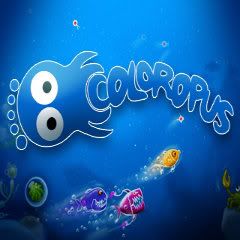
- Format:PC/Mac
- Unleashed: Out Now
- Publisher: Lace Mamba Global
- Developer: Pigsels
- Players: 1
- Site: http://colorop.us/
Coloropus is a physics based puzzle game aimed at children aged seven and over. Before we go into the game’s strengths and weaknesses though, let’s actually explore the gameplay and premise.
You play a little octopus who finds that his pink girlfriend octopus is snatched from him at every occasion. Call it a bout of ‘Princess Peachtitus’ and you’ll get the story down in a second. Hence you play through level after level trying to get to your girlfriend. You do this by changing colour and using combinations of colours to interact with and alter the environment around you. A basic example introduced near the start would be where you need to get past a blue coral obstacle. By eating a blue colour object you can then ‘fire’ blue ink at it to make it dissolve. Perhaps you need to get past an object made of a colour not available on the screen? Well, in that case you might need to eat two different colours to make the correct mixture, and so on.

This image is from the opening. It's lovely. We wouldn't call it 'cel shaded' but rather a 'hand coloured' effect'.
The game is presented utilising 2D graphics with a hand-drawn style. The game doesn’t scroll but instead you move from screen to screen by exiting via different paths. It feels like a basic flash game (some flash games nowadays feature full 3D graphics, but this is not one of them!) and plays like one.
As you progress through the game you will die. Quite a lot in fact as the difficulty curve for this title is not even paced and it doesn’t seem fair. Death, though, is not the end in Coloropus. Indeed, in this game death is just how to play the really cool bits. You will end up being taken to a one-screen mini puzzle, where you need to move your octopus’ soul (shown by a halo above your head) to your inactive, sleeping body. However, there will be obstacles and a colour coded puzzle to solve before you can simply waltz over and merge. These are some of the best puzzles in the game. In fact if Pigsels had just produced a game full of these puzzles, in a fashion similar to Angry Birds, without the plot or evil fish trying to eat you we would have been far happier and the score would have been significantly higher.
The game mechanic is a great idea, but the main plot is slow and clumsy. There is no text or spoken word. Instead we have some Star Fox style babbling with some line animation stepping in for dialogue. This is also how the game carries out its tutorial and hint system. Whilst very pretty to watch, it is very slow to execute and it results in the player being sucked out of the rhythm of the game.
Overall the main plot is an awkward mix of the core puzzle mechanic converged with some shoot em up and ‘avoid em up’ elements. Unfortunately these additional gameplay types do not suit the control scheme and movement physics. Your character is slow to move, and often the response is inconsistent. Some of the fish will attack you, and there are also other creatures who will try to grab you. The character movement just isn’t responsive enough to make these aspects of the game fun. They should be fun, but instead become a chore and a pain as more times than not an encounter like this will lead to your death.

These bubbles over character heads use a 'communication via pictionary' approach to tips and story exposition. They are slow and clumsy.
Whilst the core plot is no different from Mario, which is a title many of us older gamers play, the way it is executed in Coloropus will not attract many adult players. This is the paradox Coloropus wrestles with; it has an art style and setting ideal for 3-7 year olds, alongside a difficulty level and set of controls which will only those aged seven and above will be able to cope with.
The settings, being rather childlike in presentation, are pretty and the sound design and music are beautiful. It is a shame some of the music is not longer, or loops smoother as the sudden stop-start can break the atmosphere; but the overall tone is worthy of a mention. It certainly helps create the light, friendly and emotional backdrop the game requires to ‘sell’ the story.
Had Pigsels made the graphics and presentation darker, sped up the exposition of the narrative and released it on a touch device or turned it into a XBLA/3DS Estore title with resulting improvements in controls, this game could have provided a more consistent and balanced experience. As it is we have a great puzzle game, which all ages above seven can get some pleasure from if they can avoid becoming bogged down by the weight of the story – an element the game just doesn’t need.



Comments